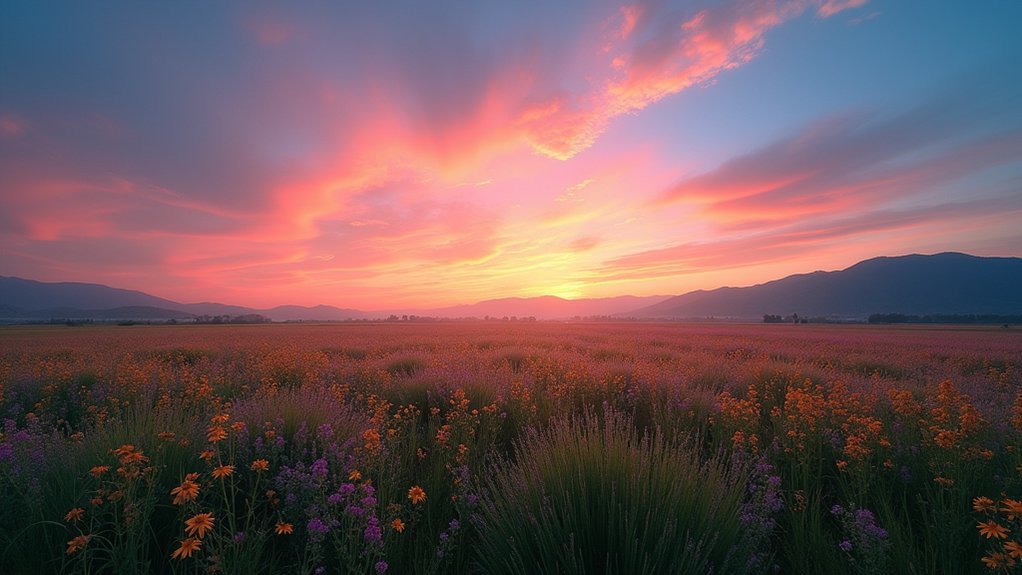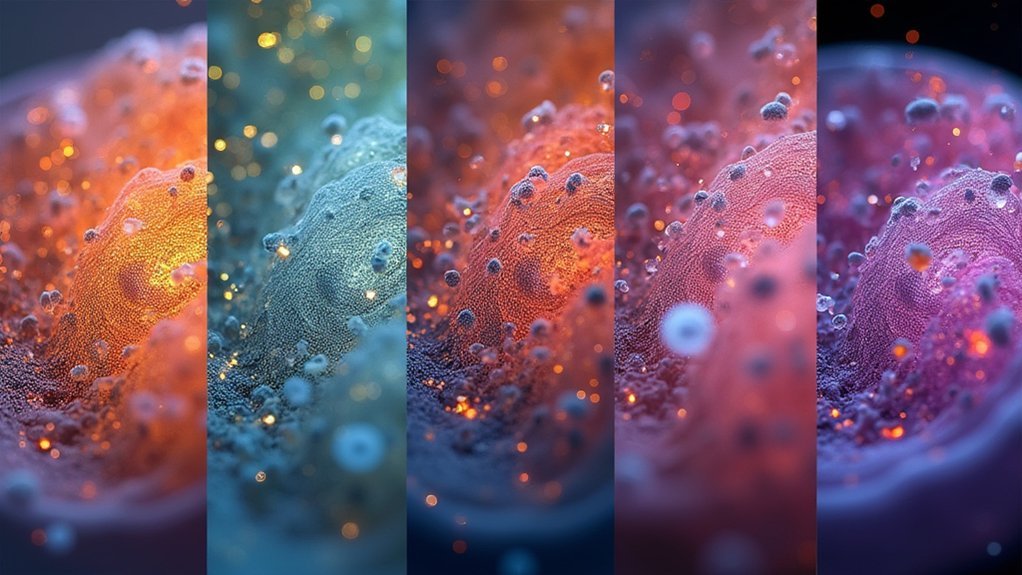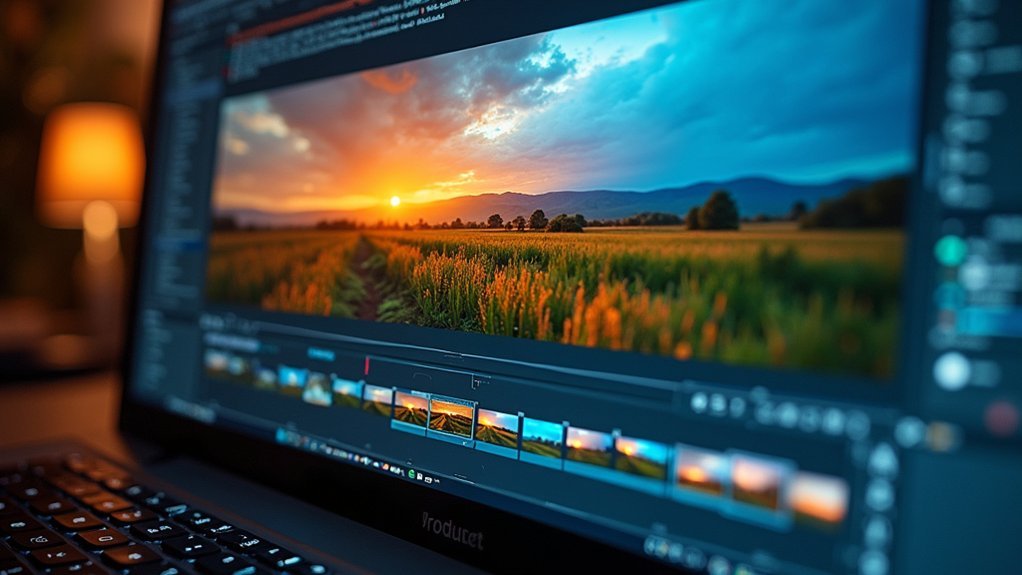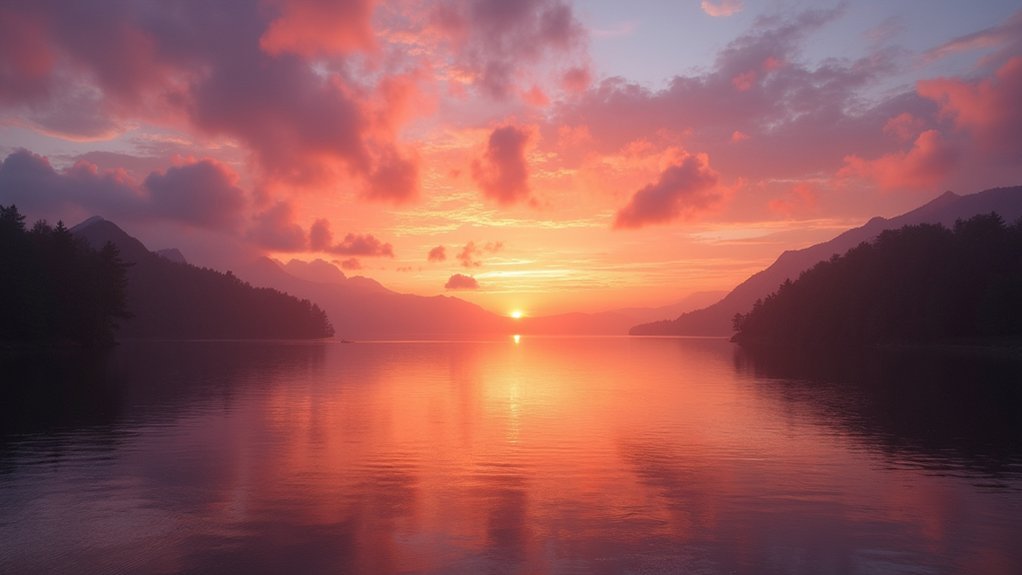For time-lapse stacking, your best options depend on your specific needs. DeepSkyStacker excels at improving signal-to-noise ratios, while StarStaX shines with its comet mode for visual trails. For professional work, paid software like PixInsight offers advanced alignment features, while free alternatives like Sequator work well for beginners. Your hardware capabilities also matter—mid-range systems handle most software efficiently, while advanced processing requires more powerful setups. The following comparison will help you make the perfect choice for your project.
Numeric List of 13 Second-Level Headings

Organization forms the backbone of any thorough guide to image stacking software. When you’re searching for the perfect tool to create stunning time-lapses, a structured approach helps you compare options efficiently.
We’ve divided this extensive guide into 13 distinct sections that explore everything from specialized astro-stacking capabilities to user-friendly interfaces.
Each heading tackles a specific aspect of stacking images, from Sequator’s noise reduction strengths to LRTimelapse’s seamless Lightroom integration.
You’ll find dedicated sections exploring StarStaX’s comet mode effects, Autostakkert!’s frame selection technology, and AfterEffects’ creative blending options.
This systematic breakdown allows you to quickly identify which software aligns with your specific time-lapse goals, whether you’re capturing star trails, cloud movements, or urban development sequences.
Understanding the Fundamentals of Time-Lapse Image Stacking
Time-lapse image stacking fundamentally differs from simple sequencing by combining multiple frames into one coherent image rather than playing them in succession.
You’ll find that different processing algorithms, particularly median and average stacking, produce distinct results when handling noise reduction and movement in your time-lapse sequences.
Choosing the right algorithm matters greatly when you’re trying to achieve specific effects like star trails or smooth water surfaces in your final time-lapse project.
Stacking vs. Sequencing Explained
When diving into time-lapse photography, you’ll quickly encounter two fundamental concepts that often get confused: stacking and sequencing. These techniques serve different purposes in your workflow.
Stacking involves combining multiple exposures into a single enhanced frame. You’re fundamentally merging stacking individual images to reduce noise, minimize flicker, and smooth out variable lighting conditions—particularly useful for sunset scenes. This process averages pixel values to create cleaner results.
Sequencing, however, is about arranging your frames chronologically to create fluid motion through time. While stacking improves quality by reducing artifacts, sequencing builds the narrative flow of your time-lapse.
Most professional results require both: stack for quality, then sequence for storytelling. Using median or average stacking methods in specialized software will help eliminate brightness fluctuations while maintaining the dynamic elements you want to showcase.
Image Processing Algorithms Compared
Beneath the surface of professional time-lapse photography lies a complex world of mathematical algorithms that transform ordinary frames into breathtaking visual sequences. When you’re seeking superior image quality, understanding these core processes is essential:
- Median and average stacking algorithms reduce noise by combining pixel values across multiple frames, creating smoother results than single exposures could achieve.
- Calibration techniques in software like DeepSkyStacker utilize flat and dark frames to remove artifacts and dramatically improve signal-to-noise ratios.
- Motion blur algorithms found in programs like LRTimelapse simulate long exposure effects without physical filters, creating fluid shifts between frames.
- Feature alignment and deflickering algorithms correct shake and eliminate luminance fluctuations, ensuring your final time-lapse maintains consistent composition and color throughout the sequence.
Evaluating Free vs. Paid Software Options for Microscope Imaging

How do you choose between free and paid image stacking solutions when budget constraints meet quality requirements?
For beginners, free options like Sequator and AutoStakkert! provide user-friendly interfaces that deliver acceptable results without financial investment. These tools handle basic time-lapse stacking efficiently for simpler microscopy projects.
However, if you’re working on detailed microscope imaging, paid software like PixInsight offers advanced alignment features and superior noise reduction—critical elements for high-quality time-lapse sequences.
While free options suffice for casual projects, community feedback suggests investing in paid solutions greatly improves image quality and workflow efficiency for professional work.
Your choice ultimately depends on project complexity—free software works for basic applications, but demanding microscopy work benefits from the enhanced capabilities and control that paid options provide.
DeepSkyStacker: Adapting Astrophotography Tools for Microscopy
Though originally developed for celestial imaging, DeepSkyStacker has emerged as a powerful tool for microscopy time-lapse work.
Its sophisticated stacking algorithms can greatly enhance your microscope images by improving signal-to-noise ratios, similar to its primary astrophotography function.
When adapting this tool for your microscopy projects, you’ll benefit from:
- Median stacking techniques that reduce noise and enhance clarity across multiple time-lapse frames
- Calibration frame support to eliminate dust artifacts that commonly plague microscope imaging
- Customizable alignment settings that adapt to various microscopy applications
- Enhanced detail capture that reveals subtle structures invisible in single exposures
Despite being designed for the stars, DeepSkyStacker’s principles apply remarkably well to microscopic worlds, offering a free yet powerful option for researchers requiring precision in time-lapse microscopy.
StarStaX: Capabilities for Microscope Time-Lapse Sequences

StarStaX transforms your microscope time-lapse sequences with its sophisticated alignment options that prevent image drift and maintain subject positioning throughout extended captures.
You’ll find the software’s advanced blending techniques, including the distinctive comet mode, create compelling visual trails and patterns that highlight object movement within your specimens.
The intuitive interface lets you easily adjust frame stacking parameters and save cumulative images, ensuring noise reduction and enhanced detail in your final microscopy compositions.
StarStaX Features Overview
A powerful ally for microscope time-lapse imaging, StarStaX offers specialized capabilities that transform sequential images into compelling visual stories.
When you stack images with this intuitive software, you’ll access tools specifically designed for creating cumulative effects that highlight cellular changes or organism development.
StarStaX delivers exceptional results through:
- Comet mode – Creates striking visual trails from moving microscopic specimens, enhancing the dynamic quality of cellular movement.
- Multiple stacking methods – Choose between average and median stacking to reduce noise and flicker in your microscopy footage.
- User-friendly interface – Simplifies the complex layering process for researchers at all technical levels.
- Flexible export options – Save your stacked creations in various formats for presentations, publications, or further analysis.
The software’s specialized design makes it particularly valuable for scientific time-lapse applications where precision matters.
Multi-Frame Alignment Options
When microscope time-lapse sequences suffer from slight specimen drift or stage movement, StarStaX’s multi-frame alignment capabilities become essential for scientific accuracy.
You’ll find that the software automatically compensates for these shifts, ensuring your microscopy data maintains integrity throughout the sequence.
The multi-frame alignment feature works by analyzing each frame and making precise adjustments before stacking, which effectively reduces noise and eliminates flicker in your time-lapse results.
For specimens that show movement patterns, the comet mode proves particularly valuable, creating visual trails that highlight directional changes.
You can also utilize the cumulative image saving options to document subtle cellular movements over extended periods without losing critical details.
This user-friendly approach makes StarStaX accessible whether you’re a beginning researcher or an experienced microscopist seeking publication-quality documentation.
Advanced Blending Techniques
Though commonly overlooked by beginners, the advanced blending capabilities within StarStaX transform ordinary microscope time-lapse sequences into fluid visualizations of cellular dynamics.
You’ll achieve seamless results by leveraging its sophisticated blending options that average multiple frames without introducing gaps.
When working with microscope time-lapse images, try these techniques:
- Utilize comet mode to create trailing effects that highlight cellular movement patterns
- Adjust blending settings to control detail preservation while adding appropriate motion blur
- Stack consecutive images with precise alignment to maintain spatial relationships between frames
- Export in various formats to share your high-quality time-lapse sequences for professional or educational purposes
These capabilities make StarStaX particularly valuable for microscopy work, where capturing subtle changes over time demands both technical precision and artistic consideration.
Helicon Focus: Specialized Features for Microscopic Detail

For photographers delving into the microscopic world, Helicon Focus stands as an exceptional tool that excels in focus stacking techniques.
You’ll appreciate its advanced algorithms that seamlessly blend individual files while minimizing artifacts and enhancing microscopic details that might otherwise be lost.
When working with time-lapse sequences, you can save your stacked images in high-quality TIFF or JPEG formats, maintaining the integrity of your microscopic subjects throughout the series.
The software gives you creative control by allowing adjustments to blending parameters and defining specific areas of interest in your frames.
For extensive time-lapse projects, you’ll find the batch processing feature particularly valuable, as it lets you stack multiple image sets simultaneously, dramatically improving your workflow efficiency when documenting microscopic changes over time.
AutoStakkert and Registax: Planetary Imaging Applications in Microscopy
While Helicon Focus excels in traditional microscopy stacking, astronomical imaging software has found surprising utility in microscopic applications.
When you’re looking for versatile software for stacking microscopy images, these planetary imaging tools offer unique advantages:
- Alignment precision – Registax’s center of gravity method guarantees your microscopy frames align perfectly, critical for capturing minute details.
- Batch processing – Both programs streamline your workflow when handling large datasets of microscopic specimens.
- Consistent cropping – AutoStakkert remembers crop sizes, maintaining uniformity across your microscopic time-lapse series.
- Format flexibility – Save your aligned microscopy stacks in various formats to accommodate different post-processing requirements.
These applications originally designed for astronomical imaging now serve as powerful alternatives for microscopy time-lapse stacking, especially when fine detail preservation matters.
Adobe Photoshop: Manual Stacking Techniques for Precise Control

The venerable Adobe Photoshop offers a distinct approach to image stacking that emphasizes manual control over automation. While not specifically designed for astrophotography, it’s well-suited for projects requiring creative flexibility.
You’ll find manual stacking particularly effective for smaller projects of 6-12 images. Begin by utilizing the “Auto-Align Layers” feature to match common elements across frames, then fine-tune positioning for perfect alignment.
By adjusting layer opacity and experimenting with blending modes like “Lighten” or “Screen,” you can enhance signal-to-noise ratio and create smoother shifts between exposures.
Manipulate opacity and test blending modes to reduce noise and create seamless transitions between stacked images.
Unlike specialized software, Photoshop doesn’t support calibration frames, but it compensates with unparalleled creative control. This makes it ideal for time-lapse sequences where you want unique visual effects rather than strictly scientific results.
Zerene Stacker: Optimizing Results for Scientific Documentation
Zerene Stacker’s precise alignment algorithms make it your go-to option when scientific documentation demands flawless image quality.
You’ll benefit from its specialized “Pyramid” and “Depth Map” stacking methods that efficiently merge multiple images into stunningly detailed composites.
For scientific fields like entomology and botany, you can rely on Zerene’s automatic alignment and retouching features to produce publication-worthy macro photographs with minimal manual intervention.
Zerene Stacker Features
Scientists and researchers seeking precision in image documentation will find Zerene Stacker’s specialized features invaluable for focus stacking applications. The software excels at handling individual images with varying perspectives, aligning them precisely to create artifact-free composites.
You’ll benefit from these core capabilities:
- Two powerful stacking methods – “Pyramid” preserves maximum detail while “Depth Map” optimizes overall sharpness.
- Advanced alignment algorithms that handle challenging perspective variations and overlapping subjects.
- Extensive batch processing functionality for efficient handling of large scientific datasets.
- Broad file format compatibility, including RAW images, allowing seamless integration with your existing workflow.
These features make Zerene Stacker particularly effective for scientific documentation where depth of field and precise detail capture are critical requirements.
Scientific Application Benefits
In professional scientific documentation, image clarity directly impacts the validity of research findings and the ability to communicate results effectively. With Zerene Stacker, you’ll transform your time-lapse sequences into exceptionally detailed scientific records that reveal subtle changes invisible to standard photography.
| Scientific Benefit | Impact on Time-Lapse | Researcher Advantage |
|---|---|---|
| Extended depth field | Captures entire specimen in focus | Complete documentation of changes |
| Preserved color fidelity | Accurate representation over time | Trustworthy visual evidence |
| Artifact minimization | Clean shifts between frames | Professional-quality publications |
| Large dataset handling | Efficient processing of sequences | Faster research completion |
| Software integration | Seamless workflow with other tools | Flexible analysis options |
When processing time-lapse sequences, Zerene’s advanced algorithms maintain image integrity while its depth merging capabilities guarantee you’ll document every essential detail across multiple focal planes.
Image Alignment Challenges in Microscope Time-Lapse Photography
When capturing time-lapse sequences through a microscope, even the slightest vibration or stage drift can derail your entire experiment.
To align the images properly, you’ll need to choose between automated and manual methods based on your specific needs.
- AutoStakkert!’s batch processing streamlines alignment of multiple frames, saving you considerable time compared to manual adjustments.
- Registax 5.1’s center of gravity feature excels with full disk microscopic subjects, providing precise alignment for consistent results.
- Manual alignment techniques offer superior control for specific cellular structures, though they require more time and expertise.
- Feature-based alignment software automatically identifies common elements between frames, reducing artifacts caused by microscope movements during capture.
Choosing the right alignment approach guarantees your time-lapse photography maintains consistent focus throughout the experimental observation period.
Batch Processing Solutions for High-Volume Microscope Imaging
Processing thousands of microscope images manually simply isn’t feasible for most time-lapse projects.
You’ll need robust batch processing solutions that automate alignment, stacking, and post-processing workflows.
Software like AutoStakkert! and DeepSkyStacker excel at handling multiple frames simultaneously, allowing you to apply consistent parameters across your entire dataset.
When alignment becomes challenging, Hugin’s feature-matching capabilities can correct unwanted movement between captures.
For more customized workflows, leverage scripting options in GIMP or Python to automate complex processing tasks.
These approaches let you apply identical adjustments to hundreds or thousands of images while maintaining quality.
Don’t overlook calibration options in advanced tools that can automatically apply dark or flat frames to your batches, greatly enhancing the final quality of your time-lapse microscopy sequences.
Flicker Reduction and Motion Blur Enhancement Techniques
Flicker and inconsistent motion often plague time-lapse microscopy, turning potentially stunning footage into distracting, jerky sequences.
You’ll find several software solutions that excel at flicker reduction and motion enhancement:
- LRTimelapse offers built-in motion blur features that mimic long exposure effects without requiring ND filters, creating smoother shifts between frames.
- AfterEffects enhances motion blur through layer duplication and blending mode adjustments, giving your time-lapse sequences a more fluid appearance.
- Sequator’s dedicated timelapse mode averages pixel values across multiple frames, effectively eliminating flickering for consistent visual output.
- Hugin’s ghosting removal capabilities reduce distractions from moving objects while maintaining scene integrity.
Median or average stacking techniques remain fundamental approaches to smooth out variations in luminance and color, ensuring your microscopy time-lapses maintain professional quality.
Software Performance Benchmarks on Various Hardware Configurations
While image quality remains paramount, the hardware requirements for time-lapse stacking software can greatly impact your workflow efficiency.
You’ll find that mid-range systems handle DeepSkyStacker and AutoStakkert! with ease, delivering excellent results with lower noise without demanding premium hardware.
If you’re working with older equipment, consider Sequator, which performs surprisingly well even on aging machines.
Time Lapse Assembler offers consistent performance across both Mac and Windows environments, making it versatile regardless of your platform preference.
For advanced processing, be aware that PixInsight’s powerful capabilities come with higher hardware demands, especially when processing large image sets.
Similarly, Hugin’s complex alignment algorithms may slow down on budget systems, so you’ll want adequate CPU power and RAM to avoid frustrating bottlenecks during your time-lapse creation process.
Frequently Asked Questions
How to Stack Timelapse Photos?
To stack timelapse photos, use specialized software like Sequator or StarStaX. Import your sequence, align the frames, choose median or average stacking techniques, and adjust blend settings to reduce noise while preserving detail.
What Is the Best Software for Time-Lapse?
For the best time-lapse software, LRTimelapse is your top choice. It offers superior motion blur control and anti-flickering features. Adobe After Effects is excellent for professional results, while Sequator provides great free options for beginners.
What Is the Best Software for Stacking Images?
For stacking images, your best option depends on your skill level: PixInsight for advanced users, DeepSkyStacker for beginners, Sequator if you need free software, or AutoStakkert! specifically for planetary imaging.
How to Create a Timelapse From Images?
To create a timelapse from images, you’ll need to capture sequential photos, import them into software like LRTimelapse or Sequator, align and stack them, then export as video at 24-30fps with optional post-processing.
In Summary
You’ll find the best results come from matching software to your specific microscopy needs. Whether you’ve chosen DeepSkyStacker for its alignment precision or StarStaX for its ease of use, prioritize tools that handle your particular specimens effectively. Don’t overlook hardware requirements—even the best software can’t overcome inadequate processing power. Experiment with different options as there’s no one-size-fits-all solution in microscope time-lapse stacking.





Leave a Reply